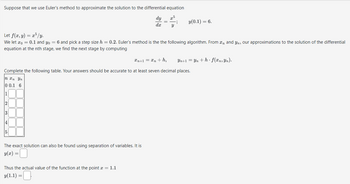
Advanced Engineering Mathematics
10th Edition
ISBN: 9780470458365
Author: Erwin Kreyszig
Publisher: Wiley, John & Sons, Incorporated
expand_more
expand_more
format_list_bulleted
Question

Transcribed Image Text:Suppose that we use Euler's method to approximate the solution to the differential equation
dy
dr
Let f(x, y) = x³/y.
We let x = 0.1 and yo = 6 and pick a step size h = 0.2. Euler's method is the the following algorithm. From an and yn, our approximations to the solution of the differential
equation at the nth stage, we find the next stage by computing
2
3
20
Y
y(0.1) = 6.
Complete the following table. Your answers should be accurate to at least seven decimal places.
n xn Yn
0 0.1 6
The exact solution can also be found using separation of variables. It is
y(x) = 0
Thus the actual value of the function at the point x = 1.1
y(1.1):
n+1 = xn+h, Yn+1 Yn+h. f(xn, yn).
Expert Solution
This question has been solved!
Explore an expertly crafted, step-by-step solution for a thorough understanding of key concepts.
This is a popular solution
Trending nowThis is a popular solution!
Step by stepSolved in 4 steps

Knowledge Booster
Similar questions
- The differential equation: +b+cx=0 has a solution given by: y = e(A sin ßx + B cos x) where a = -1.04 and 3 = 6.34 If initial conditions are y = 1.27 and dy/dt = 4.31 when x = 0, find the values of 4. Give your answer to 3 decimal places.arrow_forwardA 90 gallon tank initially contains 10 gallons of water and 5 pounds of salt. Salt solution, at 2.5 lb/gal, begins entering the tank at a rate of 4 gal/min. Simultaneously, a 3 gal/min drain is opened. in the bottom of the tank. Let s(t) be the amount of salt in the tank at time t. Find the differential equation and initial condition for which s(t) is a solution. DO NOT SOLVE THE DIFFERENTIAL EQUATION.arrow_forwardFind L{f(t)}. (Write your answer as a function of s.) Re) - { -1, 1, 0 st 0)arrow_forward
arrow_back_ios
arrow_forward_ios
Recommended textbooks for you
 Advanced Engineering MathematicsAdvanced MathISBN:9780470458365Author:Erwin KreyszigPublisher:Wiley, John & Sons, Incorporated
Advanced Engineering MathematicsAdvanced MathISBN:9780470458365Author:Erwin KreyszigPublisher:Wiley, John & Sons, Incorporated Numerical Methods for EngineersAdvanced MathISBN:9780073397924Author:Steven C. Chapra Dr., Raymond P. CanalePublisher:McGraw-Hill Education
Numerical Methods for EngineersAdvanced MathISBN:9780073397924Author:Steven C. Chapra Dr., Raymond P. CanalePublisher:McGraw-Hill Education Introductory Mathematics for Engineering Applicat...Advanced MathISBN:9781118141809Author:Nathan KlingbeilPublisher:WILEY
Introductory Mathematics for Engineering Applicat...Advanced MathISBN:9781118141809Author:Nathan KlingbeilPublisher:WILEY Mathematics For Machine TechnologyAdvanced MathISBN:9781337798310Author:Peterson, John.Publisher:Cengage Learning,
Mathematics For Machine TechnologyAdvanced MathISBN:9781337798310Author:Peterson, John.Publisher:Cengage Learning,


Advanced Engineering Mathematics
Advanced Math
ISBN:9780470458365
Author:Erwin Kreyszig
Publisher:Wiley, John & Sons, Incorporated

Numerical Methods for Engineers
Advanced Math
ISBN:9780073397924
Author:Steven C. Chapra Dr., Raymond P. Canale
Publisher:McGraw-Hill Education

Introductory Mathematics for Engineering Applicat...
Advanced Math
ISBN:9781118141809
Author:Nathan Klingbeil
Publisher:WILEY

Mathematics For Machine Technology
Advanced Math
ISBN:9781337798310
Author:Peterson, John.
Publisher:Cengage Learning,

